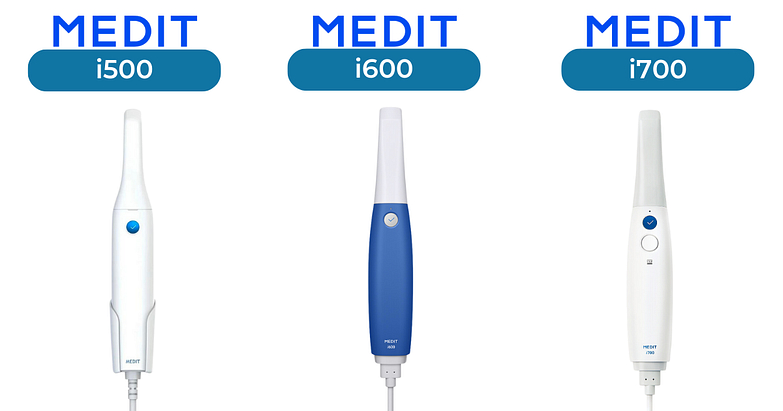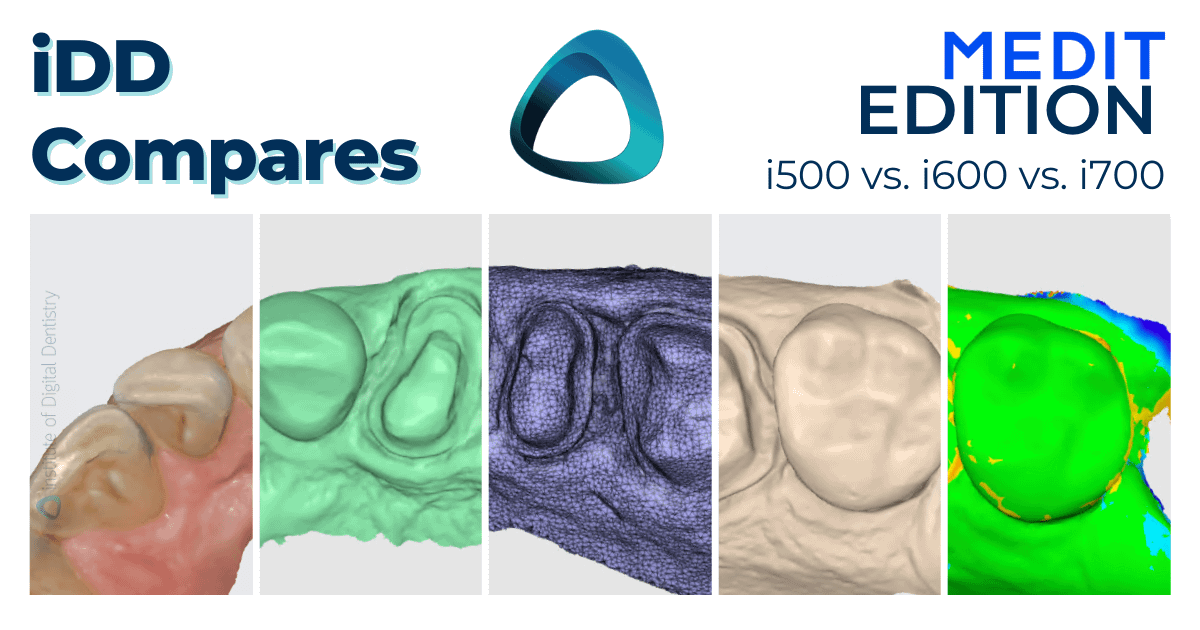From unboxing videos to intraoral scanner (IOS) reviews to free webinars and online courses, iDD has long been documented on Medit’s IOS series.
Medit Company is at the forefront of the digital dentistry revolution, establishing a name for itself by creating top-notch intraoral scanners to make the lives of dentists and patients more manageable.
Take the i500, for example, Medit’s flagship IOS model. Not only is it efficient, but it is also designed to make the scanning process a breeze for both the dentist and the patient. Followed by the upgraded sibling, the i600. It possesses everything good about the i500 and turns it up a notch. With more detail in every scan, the streamlined operation and user-friendly interface simplify navigating its features. Yet, the evolution doesn’t end there. The i700 stands as a testament to continuous innovation.
At the Institute of Digital Dentistry, we are fortunate to have access to various IOS devices including all the scanners available from Medit. So for this iDD compares, Dr. Ahmad Al-Hassiny used the following Medit IOS’ to assess their performance when capturing images of 24, 25, and 26 crowns of the same patient:

Medit's intraoral scanner devices (L-R): i500, i600 & i700.
Medit Link - Scans in their Native Software
Every IOS captures color slightly differently depending on how accurately the scanner is able to pick up light bouncing back off the prep and adjacent teeth.
Additionally, every IOS available comes with its native scanning software. They often filter out scan irregularities such as movable soft tissues, cheeks, and tongue using AI.
When we look at the processed color scans below, there only seems to be a very slight difference in scan saturation. The i500 appears to be more saturated than the i600, then followed by the i700. With regards to the scan quality or clarity of the preps, it does seem that the i700 reflects more light off the prep surface and therefore, appears slightly brighter in comparison to the i500 and i600.
Monochrome scans can often offer a clearer perspective on the preparation quality and can be advised for identifying potential scan problems less visible in color.

The processed color scans of the same tooth preparation were captured using Medit i500, i600, and i700 intraoral scanner, as previewed in their native software.

The processed monochromatic scans of the same tooth preparation were captured using Medit i500, i600, and i700 intraoral scanner, as previewed in their native software.
There does not seem to be any significant or noticeable difference between the monochrome scans across all three Medit IOS.
Exported Scan Files in Medit Design - Native CAD Software
Most intraoral scanners consist of an open architecture to allow for scans to be exported and sent to labs. These scans are usually exported in three various formats - STL, PLY or OBJ files.
STL files export as monochromatic scans whereas OBJ and PLY files store color and texture. Not all intraoral scanners are able to export OBJ and/or PLY files whereas STL files are widely used across the market as a default setting.
All three Medit IOS devices, i500, i600, and i700, can export the scan files in an STL, PLY, and/or OBJ file format.
STL File Sizes Compared
Medit i500
Medit i600
Medit i700
PLY File Sizes Compared
Medit i500
Medit i600
Medit i700
OBJ File Sizes Compared
Medit i500
Medit i600
Medit i700
The good thing about utilizing Medit IOS is the proprietary CAD software that can be used as the next step within the Medit clinic or lab workflow. Medit Design previews the received STL, PLY, or OBJ files and creates restorations based on these scans.
By exporting the scans outside their native software, we can view them objectively without the customized color and optimized surface rendering of the individual scanner’s built-in software.
All scans were exported in an STL format and previewed in the Medit Design app where we can also see the exported STL files with their tessellated mesh.

All scans were exported in an STL format and previewed in the Medit Design app.

Tessellated meshes of Medit’s i500, i600, and i700 scan as previewed in the Medit Design app.
An additional tip for those using Medit intraoral scanners - when exporting your intraoral scans you may notice that the Medit scan may appear more patchy and incomplete. This is more of a workflow issue as there's a specific way to export such files from the Medit Link software. This is done by checking the "Combine Individual Mesh" option in the Export window before exporting the files.
Scan Accuracy between Medit i500 vs. i600 vs. i700
Prep margin lines can also be reviewed in Medit Design. Current intraoral IOS devices project a light source onto the surfaces to be scanned. IOS devices generally struggle with equi or subgingival preparations (but can be managed with proper tissue and moisture control).
This light must be reflected to the IOS from the scanned surface for an accurate scan. If, instead, the light penetrates the surface and does not bounce back, it results in inaccurate scans.
Objectively looking, the margin lines for each crown prep, as viewed from the buccal perspective below in the i500, i600, and i700, are all prominent and well-defined. There does not appear to be any significant difference between the three IOS. It is important to note that if there were discrepancies in the scan regarding the margin prep, this would be more due to either the user’s scanning technique or even the dentist’s crown preparation.

Margin prep from buccal perspective of each scan as previewed in the Medit Design app.
With Medit i700 as our point of reference, we can view the deviations of its scan to both the Medit i500 and i600 when aligned using Medit Design’s Deviation Display mode.
Based on the colored deviation key, we can see that the scan meshes are -0.050 to +0.050 mm deviation compared to the scan taken with the Medit i700 reference point.
Within the same Display mode, we can view the aligned scans in a sectional view in which we can see minimal differences between the scans.

Deviation map of the Medit i700 as our point of reference when compared to Medit i500 and i600 and the crown prep sectional view.
Conclusion
iDD objectively tests and reviews intraoral scanners to help other dental professionals form their own opinions.
To better understand the comparisons and differences between the Medit IOS, read our comprehensive review comparing Medit’s i700 Wireless vs i700 vs i600 vs i500 scanners.
Keep an eye out for a future iDD Compares including Medit's newest flagship IOS, the i900, and our comprehensive review detailing our experiencing with the device.
We hope posts like this, iDD Compares, help answer some of your questions and help you make a more informed purchase.
Which IOS or type of cases would you like to see next?
If there is anything in particular you’d like us to post, let us know in the comments below.

